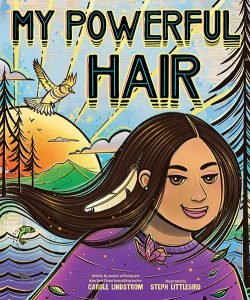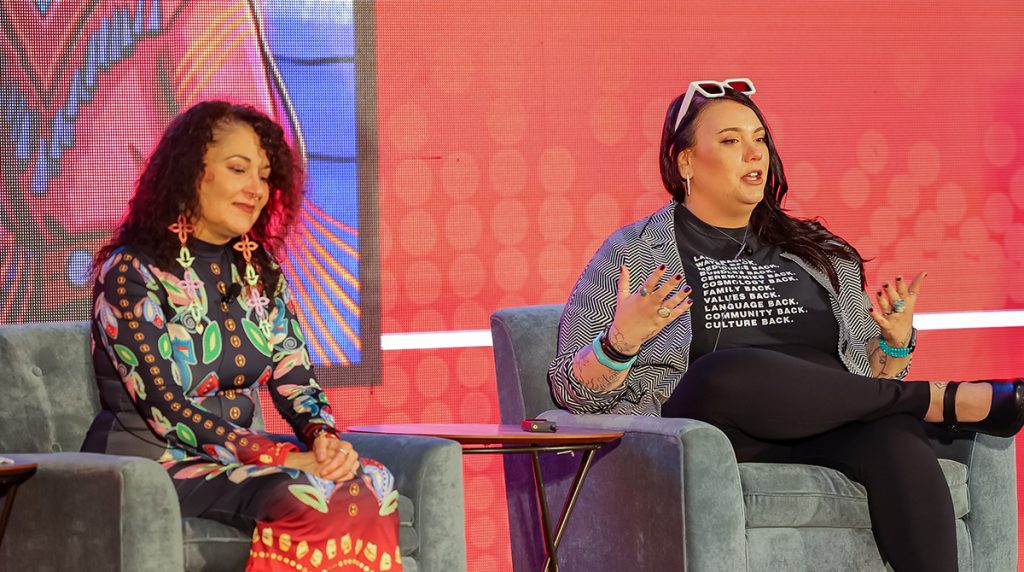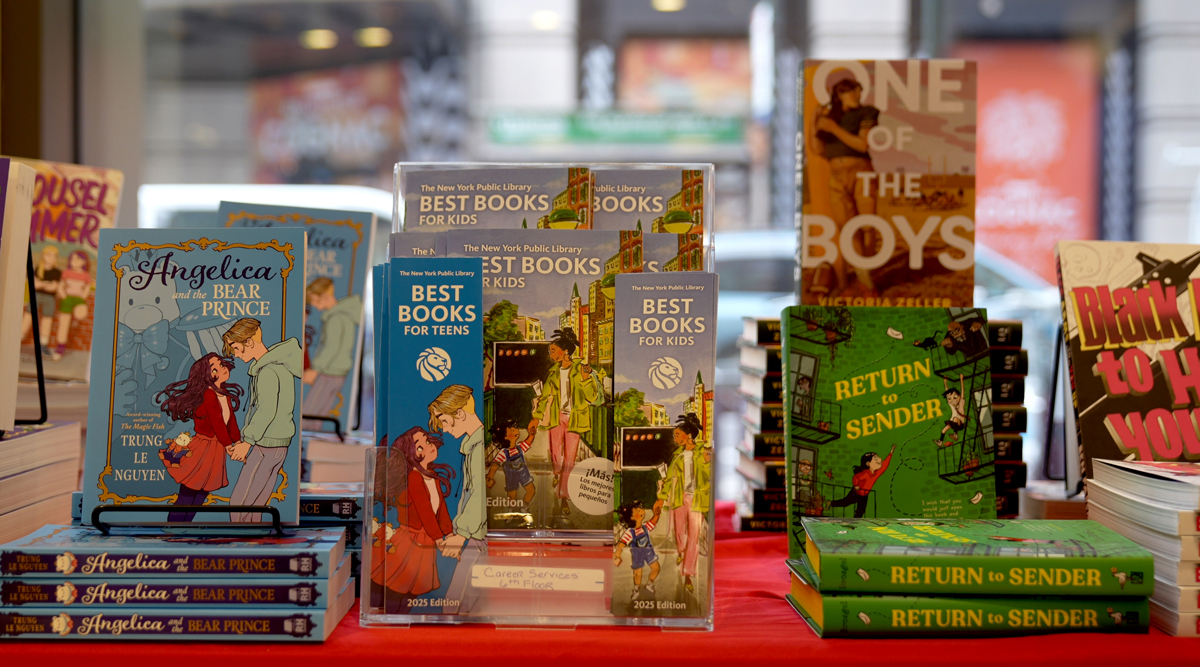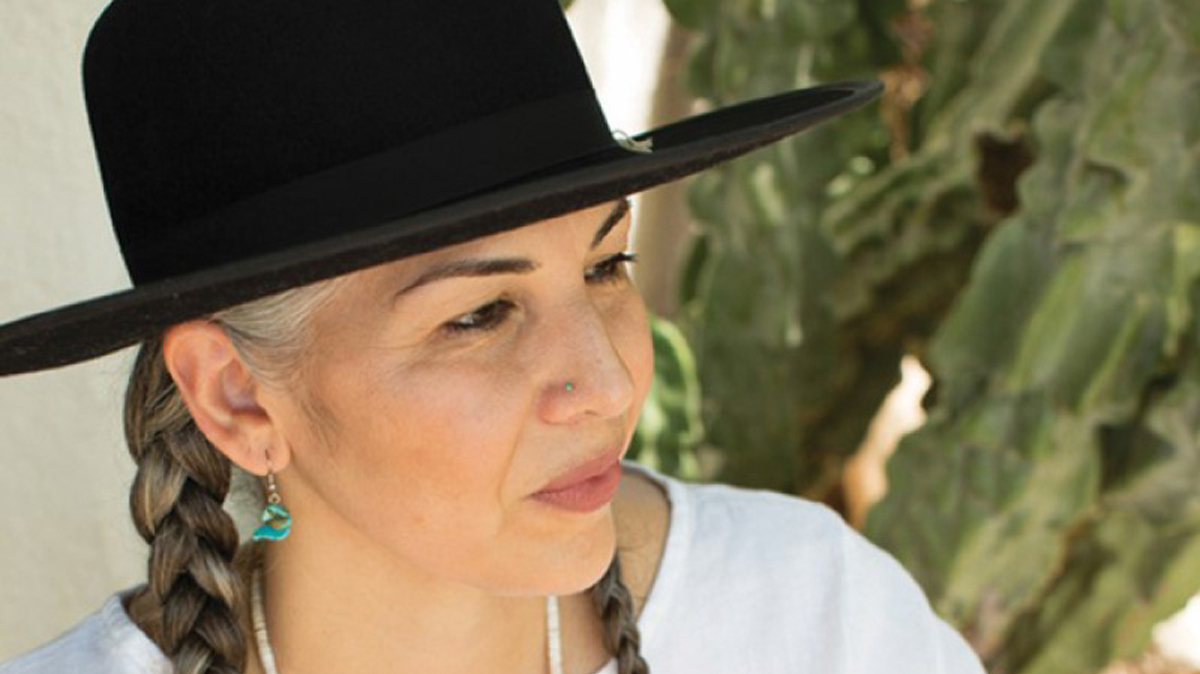Libraries have the power to amplify all kinds of stories, and that power is especially important when it comes to the stories of Indigenous people and other marginalized groups in the U.S. Author Carole Lindstrom and illustrator Steph Littlebird believe this passionately.
Lindstrom is a New York Times-bestselling, award-winning author of literature for young people, including the Caldecott Medal-winning, We Are Water Protectors. She is Anishinaabe/Métis and an enrolled citizen of the Turtle Mountain Band of Ojibwe. Littlebird is an Indigenous artist, writer, curator, and member of Oregon’s Confederated Tribes of Grand Ronde. Together they created, My Powerful Hair (Abrams Books Publishing, 2023), an empowering children’s picture book about family history, self-expression, reclaiming your identity, and the significance of hair across Indigenous cultures.
Lindstrom and Littlebird spoke with I Love Libraries in January at the American Library Association’s 2023 LibLearnX in New Orleans about the book, why it’s important and vital to tell the stories of marginalized people, their love of libraries, and more. This Native American Heritage Month, we’re proud to share this conversation.
Carole, what inspired you to write this book?
Carole: What inspired me to write it was a photograph I saw in our house of my grandma and my two great aunts. It was a black and white picture, and they had their hair cut really short and were wearing smocks. I was surprised by that, so I asked my mom what that picture was for. She said it was when my grandma went to Indian boarding school. I didn’t really know anything about it and neither did my mom because all of the history of when grandma went to Indian boarding school was erased. There was just a lot of shame in our family for being native.
That story just kept coming back to me. As a child, I always had short hair, and I never really understood why until I got older. My mother would always say my hair looked wild; you know, “wild Indian,” that kind of thing, because that’s the connotation that grandma had in boarding school. So I wanted to tell a story about a young girl who was growing her hair long and felt empowered to do it.
Why is it important to tell this particular story for young readers?
Carole: Well, I love to write for young people, because young people get it. They just get it, you know? They don’t have all the complications that adults bring to things. They’re very open-minded and understanding; just sponges absorbing things. They’re curious and exploring the world around them and trying to learn about it. A book like this would have been something I would have wanted when I was at their age.
Did you collaborate with each other during the creation of the book? Or did you receive the text after it was completed, Steph? What was the process like?
Steph: Carole had a sort of divine inspiration with this book, so I got the text sort of already in place and it was my job to envision it. It was a pleasure working with Carole. There was this beautiful balance of receiving feedback, but also being allowed to express my unique view as an artist. It’s amazing when you’re allowed to do that, especially a project with a New York Times-bestselling author. I was given a lot of freedom to use my imagination while also getting great feedback.
Do you like to have back and forth with a writer, or do you like to, just as you said, just let your imagination go?
Steph: I like both. As an artist working with other people or clients, you have to be used to receiving feedback. But for me, working with another Indigenous author is unique in that we’re bringing something that’s very special to both of us culturally and personally. Bringing it to life was a pleasure for me, but also a pleasure to work with Carol and the publishers. Their feedback was always valuable. I enjoy that balance. I get better with feedback. It’s a good part of the process. If you’re getting good feedback, you can become a better artist.
What do you hope young readers take away from your book?
Carole: I hope Indigenous children feel proud of themselves and honored when they read this story. To see yourselves in a book is such a big, powerful thing for Native peoples, especially one that’s accurate and shows their lives the way they are. So I just hope that Indigenous children feel seen, and I hope that non-Indigenous children will see, as well. It’s like windows and mirrors, you know? Children should be able to see themselves in books, but they should also see others in books. That’s why I love writing for young people because the world is just new to them. I can’t imagine writing for anybody else but young people, it’s just fun.

Steph: It’s also an important topic right now. It’s tied into a SCOTUS decision that’s coming down in just a few months. The Indian Child Welfare Act is directly related to how Indigenous children have been treated historically by non-Native people. This story is talking about the history of how we have been treated through colonization and how we have had to recover our identity in many ways. That’s something I think that a lot of people can identify with in different ways, but also the conversations around ancestry and our connection to the earth are really important. I feel like both children and adults can use that information to connect deeper with themselves and each other. This book has so many important messages that are good for both children and adults to hear.
How can libraries help tell and preserve the stories of Indigenous peoples in the U.S., especially now when books by and about marginalized peoples and communities are being banned, challenged, and removed from schools and libraries?
Carole: Oh, libraries! I love libraries! They have so much power. I go to my local library probably three or four times a week, and I get stacks of books to read. And I go back to the library and get even more stacks more books to read. I don’t know why. I think maybe I’m a book hoarder!
One thing that my library does, and I know a lot of them do, is they put out book selections. I go in all the time and look at them, because the librarians pick books that I’ve never seen before. I’m always like, “Oh my gosh, I never knew this author. What is this book?” But I’ve also seen libraries select books like the Little House in the Prairie series to showcase, and those are not books that we need to see. Those books hurt me very badly as a young person, because I didn’t see myself in them. I was very torn. The book’s calling me a savage, but I’m not; the family [in the books] loved each other and they got along, and my family life was not like that. I struggled with how they can be such nice people but think of me as a savage when I don’t think I’m a savage. We’re not like that. I didn’t know what that meant.
I’m not ever saying those books should be banned, just don’t highlight them. There are so many books by Indigenous people, about Indigenous people, that I would have loved to have gotten my hands on as a kid. When librarians put those books out, they’re doing such a great service for people coming in because books can get lost in the stacks. But when librarians make a conscious effort to showcase books that are current and relevant today, that’s huge. Librarians are huge. And I love them.
Steph: Librarians have been great teachers of mine throughout my life, both as a young person and when I was in college. They do have power. They have immense power because they are the keepers of knowledge in many ways. So featuring books like this about marginalized people is really important because, even though we are marginalized-even if we’re talking about broader POC representation in children’s books, we might be marginalized-we’re not the minority necessarily. There are so many people who have experienced marginalization in their lives who can connect with this story or other stories related to POC experiences.
These books help us understand both ourselves, but also each other. That’s what is so important about sharing these stories. Librarians have the power to expand people’s minds and empower them through stories. Libraries are such an important place in our communities, and they have so much more power than people realize.
Do you either do have an anecdote or story about libraries from your past or present that you’d like to share?
Carole: When I was little, we had a teeny tiny library in my hometown in Nebraska, where I was born and raised. It was kind of far away from the house, and mom could only take us every now and then because it was a considerable drive. But when a new library opened right down the street from our house, I was there every weekend. It was a good place for me to escape. There was one librarian there-she was an older woman and I don’t know her name and she didn’t know my name-but I looked for her every time I went into that library. When I saw her, it comforted me. You know, librarians probably don’t even know how many lives they touch, but they did mine. The library saved my life as a child, because I got to go there on the weekends and all I did was sit in stacks, mostly with the nonfiction books because I wanted to understand the world. I’d just sit on the floor all day, and look up books about whatever I was interested in. I’d spend my days doing that.
I love the library. I can still see that librarian in my head. I think that librarians maybe sometimes don’t understand the impact they have on young people, but I’m going to tell you, you they do. Always know that, because there’s a little girl or boy in the library that comes every day to see you and may not even know it. And you’ve made their lives so much better.
Steph: I feel the same way about libraries. When I was younger, they were a refuge for me being in a home that wasn’t super safe or, you know, “normal,” I guess would be the word. The library became a place where I could escape my reality. It’s interesting to be a children’s book illustrator now and think about the books that impacted me as a child. [Author and illustrator] Steven Kellogg was very important when I was a child going to libraries. I would get lost in his books and think about these worlds that existed outside of my own. That’s why books are so powerful, whether they’re a picture book or a written book. They allow readers to get away from things and to feel safe or to imagine different realities. For me, libraries were a place where I could go and be safe and where I could be quiet with myself and learn about myself and learn about the world. They are so important and have been a refuge for me throughout my life for sure.
Carole: You know what I was just thinking about? I was thinking how every time I go to the library and get a book, I still come out and go, “How is it possible that you can go into a building and take a book home for free?” I hope that people really understand how important libraries are because that is a gift. It really is, and I still am very grateful for that gift.
Photo: Author Carole Lindstrom (left) and Steph Littlebird at 2023 LibLearnX in New Orleans.




